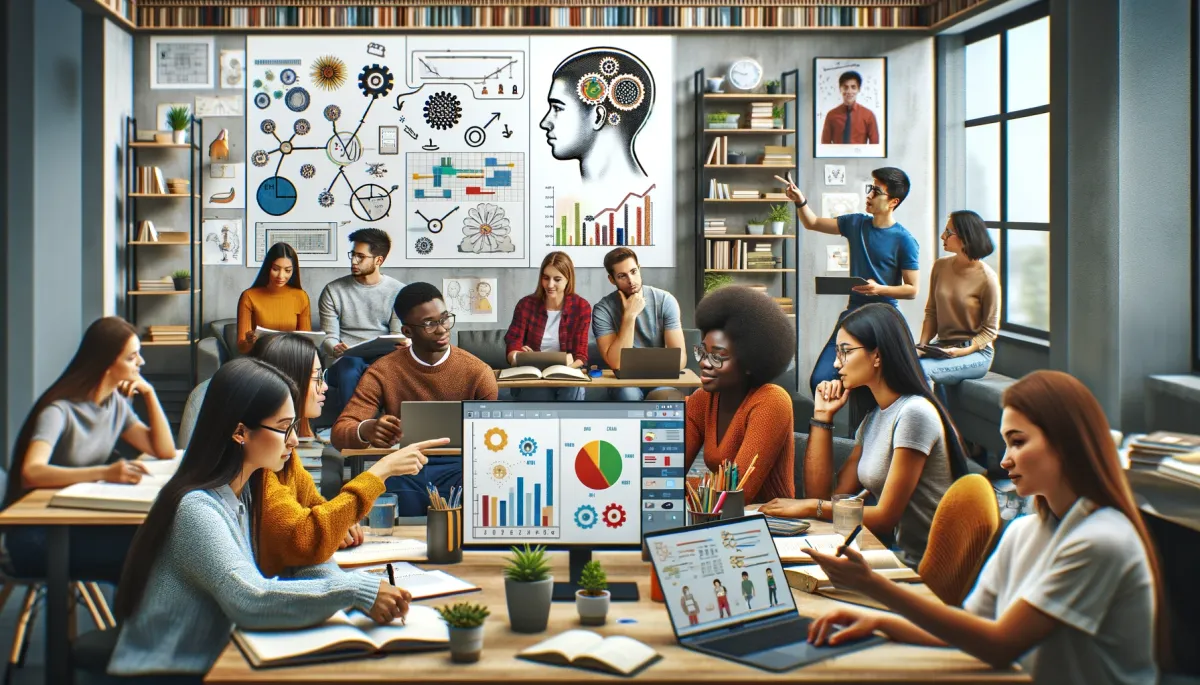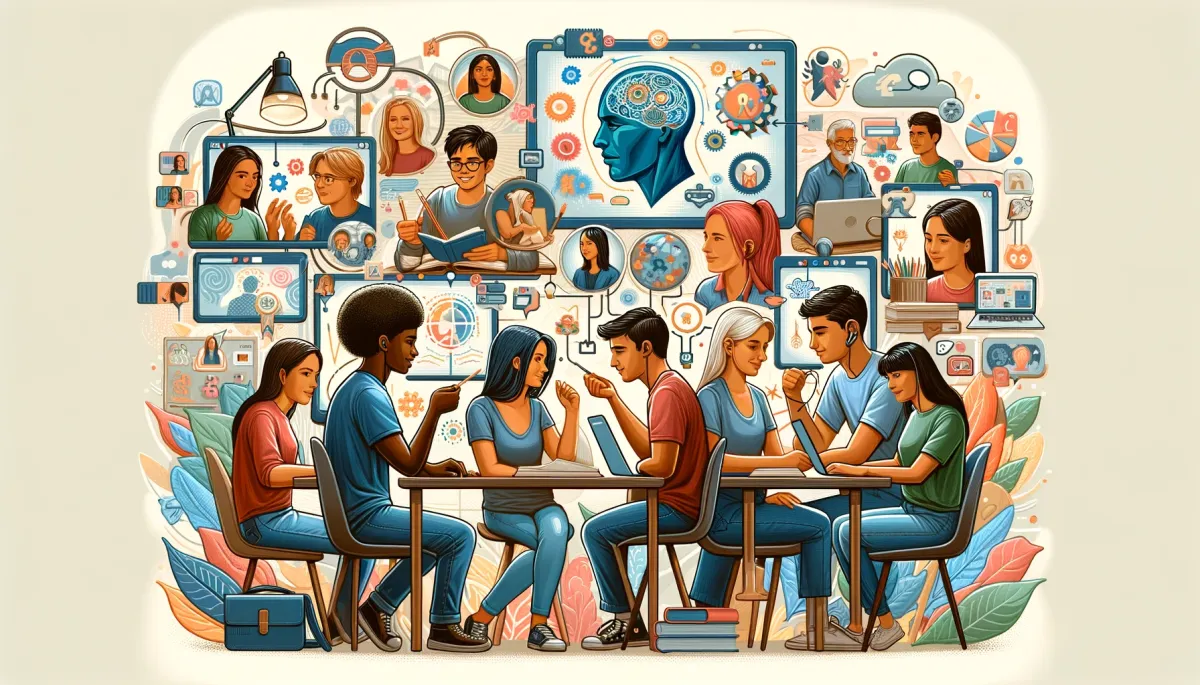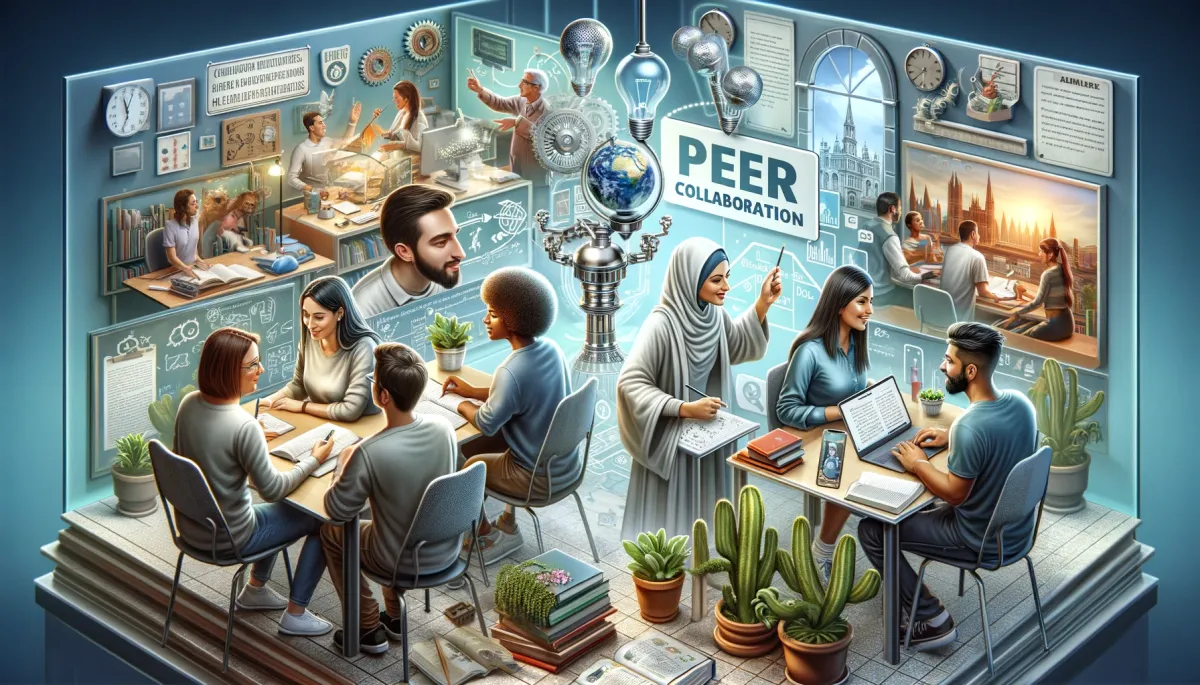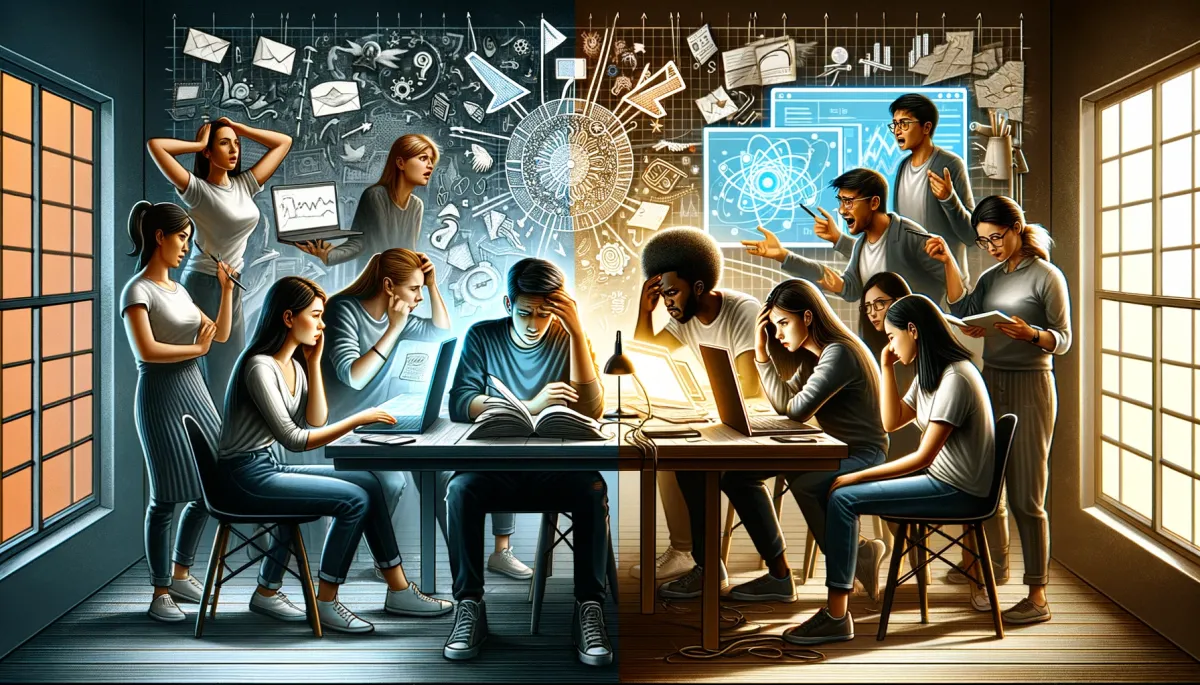Peer Collaboration Strategies For Online Tutoring

Fanie Naude
CEO & Founder of Knowledgeable Tutor, Buznet Direct, YMC & Naude Consulting

Fanie Naude
CEO & Founder of Knowledgeable Tutor, Buznet Direct, YMC & Naude Consulting

1. Introduction
The digital age has revolutionized the way we approach education, and online tutoring is no exception. As we navigate this new frontier, one aspect remains crucial for educational success: student engagement. Peer collaboration serves as a linchpin in this context, offering a myriad of benefits that range from enhanced learning outcomes to improved social skills. This article aims to be your ultimate guide to understanding and implementing peer collaboration strategies in online tutoring.
"Coming together is a beginning, staying together is progress, and working together is success." - Henry Ford
Why is Peer Collaboration Important in Online Tutoring?
- Enhanced Learning: Collaborative learning can lead to higher retention and understanding of the subject matter.
- Social Skills: Working in groups helps students develop essential social skills like communication and empathy.
- Motivation: A sense of community and shared goals can significantly boost student motivation.

2. The Psychology Behind Peer Collaboration
Understanding the psychology behind peer collaboration can offer invaluable insights into how to effectively implement it in an online tutoring setting. Let's delve into the cognitive, emotional, and social aspects that come into play.
Social Learning Theories
Social learning theories like Bandura's Social Learning Theory posit that learning is a social process. Students are not just passive recipients of information but active participants in the learning process. They learn from observing, imitating, and interacting with their peers. According to a study by Stanford University, students engaged in collaborative learning showed a 75% increase in retention rates compared to those who learned individually.
Cognitive Benefits
Cognitively, peer collaboration enhances critical thinking and problem-solving skills. When students work together, they are more likely to engage in higher-order thinking, question assumptions, and explore alternative solutions. A Harvard study found that collaborative learning strategies could improve critical thinking skills by up to 50%.
Emotional Benefits
On the emotional front, collaborative learning fosters a sense of community and belonging among students. It helps in reducing anxiety and increasing self-esteem. A report by the American Psychological Association highlighted that students who felt a sense of belonging in educational settings had better mental health outcomes.
By understanding these psychological aspects, tutors can tailor their teaching strategies to maximize the benefits of peer collaboration in online tutoring environments.

3. Benefits of Peer Collaboration
Peer collaboration in online tutoring is not just a buzzword; it's a multifaceted approach that offers tangible benefits. These benefits span across academic, social, and emotional domains, creating a holistic learning environment for students.
Academic Performance
One of the most compelling benefits is the enhancement of academic performance. When students collaborate, they are exposed to diverse perspectives and problem-solving approaches. This diversity enriches their understanding of the subject matter. According to a study by the National Education Association, students who engaged in collaborative learning scored 30% higher in tests compared to those who did not.
Social Skills
Collaborative learning also serves as a platform for students to develop essential social skills. Skills like communication, empathy, and teamwork are honed during group activities. As the saying goes, "Two heads are better than one," and this collective wisdom is what makes peer collaboration so effective.
Emotional Well-being
The emotional benefits are equally noteworthy. Students who engage in peer collaboration often report higher levels of motivation, self-esteem, and a sense of belonging. These emotional gains are not just feel-good factors; they directly contribute to better learning outcomes.

4. Challenges and Solutions
While the benefits of peer collaboration are numerous, it's not without its challenges. However, understanding these challenges can help us find effective solutions.
Unequal Participation
One common issue is unequal participation, where some students dominate the discussion while others remain passive. This can be mitigated by assigning specific roles to each student and rotating these roles periodically. A study by the University of Michigan suggests that role rotation can increase participation by up to 60%.
Technical Issues
In an online setting, technical issues like poor internet connectivity can also pose challenges. Tutors can address this by having a backup plan, such as pre-recorded sessions or downloadable resources. This ensures that learning is not interrupted.
By proactively addressing these challenges, tutors can create a more equitable and effective collaborative learning environment.
"The strength of the team is each individual member. The strength of each member is the team." - Phil Jackson

5. Core Strategies for Peer Collaboration
The effectiveness of peer collaboration in online tutoring is largely dependent on the strategies employed. Here, we delve into some of the most impactful techniques that can be seamlessly integrated into your online tutoring sessions.
Jigsaw Technique
The Jigsaw Technique is a cooperative learning strategy where students are divided into groups and each member is assigned a specific topic. After researching their topic, they teach it to their peers. This method not only enhances subject matter expertise but also improves teaching skills among students. According to a study by Vanderbilt University, the Jigsaw Technique improved both teaching and learning outcomes by 40%.
Think-Pair-Share
Another effective strategy is Think-Pair-Share, where students first think about a question individually, then discuss it with a partner, and finally share it with the class. This strategy encourages active participation and critical thinking. A report by the University of California found that Think-Pair-Share increased student participation by 50%.
Sub-section: Gamification Techniques for Enhanced Student Engagement
Incorporating gamification techniques like badges, leaderboards, and challenges can add an element of fun and competition, further enhancing engagement.

6. Tools for Facilitating Peer Collaboration
In an online setting, the choice of tools can make or break the collaborative experience. Here are some categories of tools that can facilitate effective peer collaboration.
Software
Various software solutions are designed specifically for educational collaboration. These include virtual whiteboards, breakout rooms, and interactive quizzes. Tools like Zoom and Microsoft Teams have features that support collaborative learning.
Platforms
There are also specialized platforms like Moodle and Blackboard that offer a range of features for online collaboration. These platforms provide a centralized space for resources, discussions, and assessments.
Sub-section: Interactive Tools for Student Participation in Online Tutoring
Explore a curated list of interactive tools that can be integrated into your online tutoring sessions to enhance student participation and collaboration.
"Alone we can do so little; together we can do so much." - Helen Keller
By employing these strategies and tools, tutors can create a conducive environment for effective peer collaboration, thereby enriching the learning experience.

7. Case Studies
Case studies serve as empirical evidence that can validate the effectiveness of peer collaboration in online tutoring. These real-world examples offer insights into what works and what doesn't, providing a roadmap for tutors to follow.
Promoting Collaboration in Online Project-Based Learning
A study by ERIC explored how online project-based learning can promote collaboration among students. The study found that structured online projects led to higher levels of engagement and better learning outcomes.
Collaborative Learning in Small Groups
Another case study published in BMC Medical Education focused on collaborative learning in small groups. The study revealed that students who engaged in small group activities had better retention rates and improved critical thinking skills.
Sub-section: Maintaining Student Engagement in Online Tutoring
For more insights on how to maintain student engagement during online tutoring sessions, including peer collaboration strategies, visit this section.

8. How to Measure the Effectiveness of Peer Collaboration
Measuring the effectiveness of peer collaboration is crucial for continuous improvement. Here, we discuss the key performance indicators (KPIs) and metrics that can help you gauge the success of your collaborative efforts.
KPIs
Key Performance Indicators such as student engagement levels, completion rates, and grades can offer valuable insights. For instance, a rise in student engagement levels post-collaboration could be a positive indicator.
Metrics
Other metrics like student feedback, time spent on tasks, and peer evaluations can also provide a comprehensive view of the effectiveness of peer collaboration strategies.
"What gets measured gets managed." - Peter Drucker
By employing these KPIs and metrics, tutors can not only measure but also enhance the effectiveness of peer collaboration in online tutoring.

9. Tips for Tutors
Tutors play a pivotal role in facilitating effective peer collaboration in online tutoring. Their approach can significantly influence the success of collaborative learning strategies.
Facilitation Techniques
Effective facilitation techniques include setting clear objectives, providing timely feedback, and ensuring equitable participation. These techniques can guide the collaborative process and make it more productive.
Encouraging Participation
Tutors can encourage participation by creating a safe and inclusive environment. This includes acknowledging contributions, asking open-ended questions, and providing constructive feedback.
Sub-section: Creating Engaging Assignments and Activities in Online Tutoring
For a deeper dive into how to create engaging assignments and activities that can be used in peer collaboration, visit this section.

10. Future Trends
As technology evolves, so do the methods and tools available for peer collaboration in online tutoring. Here are some future trends that are set to revolutionize the way we think about collaborative learning.
AI in Peer Collaboration
Artificial Intelligence (AI) is set to play a significant role in automating and enhancing various aspects of peer collaboration. AI can help in grouping students based on learning styles, providing real-time feedback, and even automating administrative tasks.
Virtual Reality
Virtual Reality (VR) offers an immersive learning experience and can be particularly effective in collaborative settings. Imagine students taking a virtual field trip together or collaborating in a virtual lab.
"The best way to predict the future is to invent it." - Alan Kay
By staying abreast of these future trends, tutors can prepare themselves for the evolving landscape of online education and peer collaboration.

11. FAQs
The Frequently Asked Questions (FAQ) section aims to address common queries and concerns that readers may have about peer collaboration strategies in online tutoring. This section is designed to be a quick reference guide, providing concise yet comprehensive answers.
1. What is the Jigsaw Technique in Online Tutoring?
The Jigsaw Technique is a cooperative learning strategy where students are divided into groups, and each member is assigned a specific topic to research and teach to their peers. This method enhances subject matter expertise and improves teaching skills. For more details, refer to the Eduflow article.
2. How Can Online Teachers Overcome the Challenge of Student Isolation?
One of the primary issues with distance online learning is isolation. Cohort-based courses can help overcome this challenge by facilitating peer collaboration. More on this can be found in this Teachfloor article.
3. What Are Some Traditional Classroom Strategies That Can Be Adapted for Online Tutoring?
Traditional classroom strategies like cooperative learning can be adapted for online tutoring. For instance, the Think-Pair-Share strategy can be effectively used in a virtual classroom setting. For more, read this article by GWU.
4. How Can Tutors Encourage Collaboration Among Themselves?
Tutors can collaborate by sharing best practices, co-creating content, and even co-hosting sessions. This not only improves teaching practices but also enhances learner outcomes. For more insights, check this LinkedIn advice.
5. How Can Tutors Address Social Location and Power Dynamics in Peer Tutoring?
Tutors can address these issues by creating an inclusive environment and being mindful of the diverse backgrounds of their students. For more strategies, refer to this LinkedIn advice.
"The only stupid question is the question that is never asked." - Ramon Bautista

